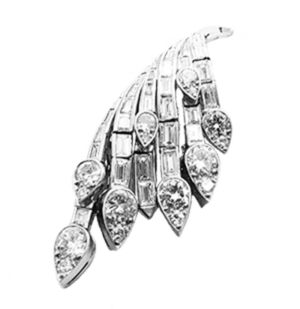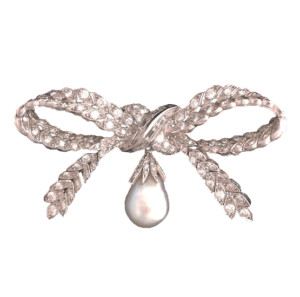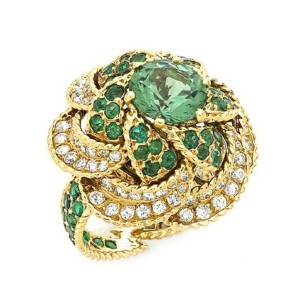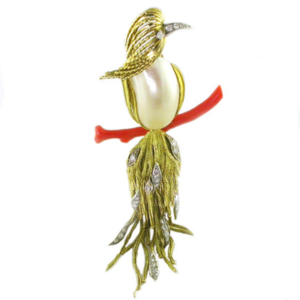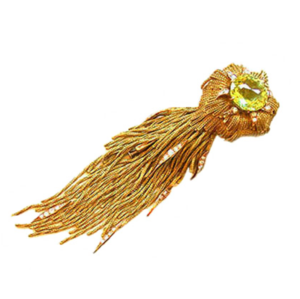(1905 – 1978)
LITERATURE: STERLÉ Joaillier Paris, by Viviane Jutheau; BIJOUX DES ANNEES 1940 – 1950, by Sylvie Raulet; DICTIONNAIRE INTERNATIONAL du BIJOU, Editions du Regard, pp304-305
Unlike many of his competitors, Pierre Sterlé did not come from generations of jewelers – he came from a family of well placed bureaucrats, with nothing to suggest his future “metier”. His father disappeared during WW1, and he was taken under the wing of an uncle, Maynier-Pincon, who just happened to be jewelry maker. Pierre learned his jewelers’ skills in his uncles’ workshop. In 1934, at the age of twenty-nine, he opened his own atelier on the rue St Anne in Paris, and in addition to his own designs, he did work for many prestigious jewelry houses, Boucheron, Ostertag and Chaumet among them.
By 1945, he had attracted a substantial clientele for his very personal, vivacious and dynamic designs. Amazingly enough, Sterlé did not actually do any designing himself, although it was reported that while working for one of the great French couturiers, he plucked a petal from a vase of roses, and used a simple straight pin to attach it to the shoulder of a dress – it was so perfect that he had it made in platinum and diamonds, and it was one of his first jewels.
Generally, though, he relied on the talents of several excellent designers to interpret his ideas. Prior to 1960, his principal designer was Jacques Desnoues, who was succeeded by Yves Poussielgues.
Sterlé soon opened a salon on the prestigious avenue de L’Opera – in fact, his makers mark has the facade of the Opera on it. Although he did not have a street-level shop, all the chic women managed to find him, not to mention King Farouk and the Maharani of Baroda – major jewelry buyers. The writer Colette was also enamored of his jewels.
His jewelry designs of the late 1940’s and early 1950’s used supple, braided and twisted gold ropes, festooned and often hung with fringes in the “Passemeterie” style. He used gold wire, very much in fashion in the 1950’s, in novel ways, often twisting it for greater effect, and was humorously nick-named “the torturer of wire”. He made great use of fox-tail chain, using it to represent the feathers of a bird, the trailing tentacles of a sea creature, fins of a fish, the stamens of flowers, and in many other places where movement added to the grace and humor of a jewel. He loved color, and used coral, turquoise, mother-of pearl and other semi-precious stones as an artist would use paint, and often used both precious and non-precious stones in the same piece.
When he chose to work in diamonds, however, his jewels have a restrained grace and elegance that is uniquely his. Ribbons of round and baguette diamonds in white gold or platinum mountings swirl around each other, or form wing or leaf shapes. Tassels of diamonds flutter from necklaces and bracelets, Sterlé’s jewels are often characterized by an intriguing dis-symmetry. This was a clever way of giving an even greater sense of movement to the piece.
His non-figurative designs are radiant or elongated, and as we go into the 1960’s they become even more exuberant. He often used row upon row of fine, twisted wire to build high and dramatic rings. Flowers of mother-of-pearl or coral were carved with the most exquisite realism. Birds on branches, with bodies of pearl, coral or colored hard-stone perched on a branch became perhaps his most iconic pieces. In fact, the range and originality of Sterlé’s designs is overwhelming.
Sterlé had done some designing for the house of Chaumet during the 1950’s. He had never had a street-level retail establishment, always preferring the privacy and exclusivity of an office salon. After a few tentative efforts to open a retail shop, he decided instead to become technical advisor to Chaumet, who also bought up his unsold stock in 1976. Thus, some of Sterlé’s jewelry from this period is signed by Chaumet, although thee designs are distinctively Sterlé. A note of caution — at some point, Sterlé or Chaumet gave the rights to the Sterlé name to a jeweler in New Orleans. Thus, there are pieces of jewelry on the market that are signed Sterlé, but do not have French marks, and were neither made nor designed by him.
Piere Sterlé worked for Chaumet until his death in 1978.
Showing all 5 results
-
$2,000,030,000.00
-
$3,000,040,000.00
-
$3,000,040,000.00


